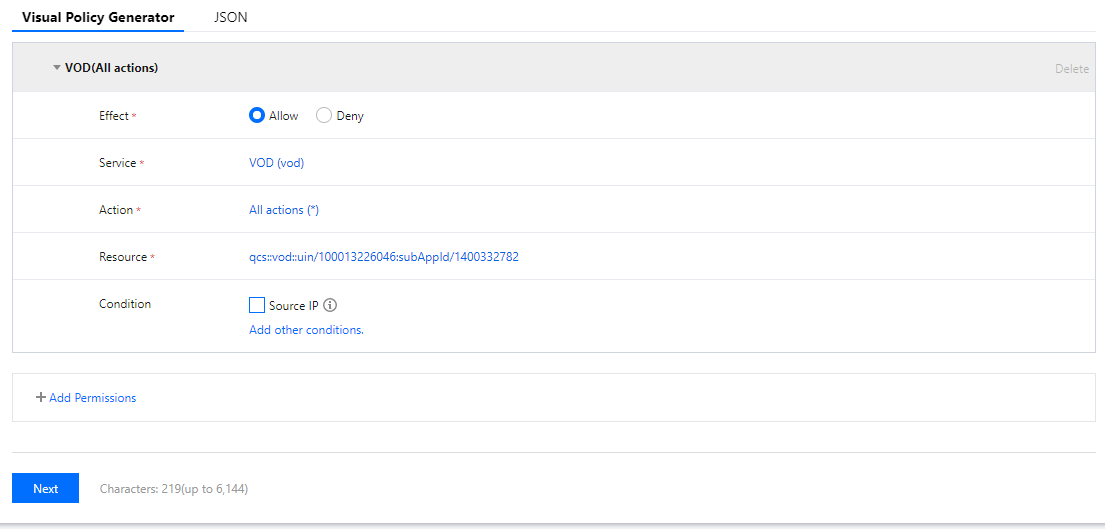自定义策略
最后更新时间:2022-05-31 11:04:02
注意:
自定义策略创建方法
自定义策略有多种创建方法,下方表格展示各种方法的对比,具体操作流程请参考下文。
创建入口 | 创建方法 | 效力(Effect) | 资源(Resource) | 操作(Action) | 灵活性 | 难度 |
控制台 | 策略生成器 | 手动选择 | 语法描述 | 手动选择 | 中 | 中 |
控制台 | 策略语法 | 语法描述 | 语法描述 | 语法描述 | 高 | 高 |
服务端 API | CreatePolicy | 语法描述 | 语法描述 | 语法描述 | 高 | 高 |
说明:
云点播不支持按照产品功能创建自定义策略。
手动选择是指用户在控制台所展示的候选项列表中选择对象。语法描述是指通过策略语法来描述对象。
策略语法资源描述
如上文所述,云点播权限管理的资源粒度是子应用。子应用的策略语法描述方式遵循 CAM 标准。在下文的示例中,开发者的主账号 ID 是12345678,APPID 是1250000001(主应用 ID 等于 APPID),开发者创建了两个云点播子应用,ID 分别是1400000001和1400000002。
云点播所有资源的策略语法描述
"resource": ["qcs::vod::uin/12345678:subAppId/*"]
主应用的策略语法描述
"resource": ["qcs::vod::uin/12345678:subAppId/1250000001"]
单个子应用的策略语法描述
"resource": ["qcs::vod::uin/12345678:subAppId/1400000001"]
主应用和单个子应用的策略语法描述
"resource": ["qcs::vod::uin/12345678:subAppId/1250000001","qcs::vod::uin/12345678:subAppId/1400000001"]
策略语法操作描述
如上文所述,云点播权限管理的操作粒度是服务端 API。在下文的示例中,以
DescribeMediaInfos、DescribeAllClass等服务端 API 为例。云点播所有服务端 API 的策略语法描述
"action": ["name/vod:*"]
单个服务端 API 操作的策略语法描述
"action": ["name/vod:DescribeMediaInfos"]
多个服务端 API 操作的策略语法描述
"action": ["name/vod:DescribeMediaInfos","name/vod:DescribeAllClass"]
自定义策略使用示例
使用策略生成器
在下文示例中,我们将创建一个自定义策略。该策略允许对1400000001这个云点播子应用进行任何操作,除了
ProcessMedia这个服务端 API。2. 选择按策略生成器创建,进入策略创建页面。
3. 选择服务和操作。
效果(Effect)配置项选择允许。
服务(Service)配置项选择云点播。
操作(Action)配置项勾选所有项。
资源(Resource)配置项按照 资源语法描述 说明填写
qcs::vod::uin/12345678:subAppId/1400000001。条件(Condition)配置项无需配置。
使用策略语法
在下文示例中,我们将创建一个自定义策略。该策略允许对1400000001和1400000002这两个云点播子应用进行任何操作,但不允许对1400000001进行
ProcessMedia操作。2. 选择按策略语法创建,进入策略创建页面。
3. 在选择模板类型框下选择空白模版。
说明:
所谓策略模版,指新策略是现有策略(预置策略或自定义策略)的一个拷贝,然后在此基础上做调整。在实际使用中,开发者可以根据情况选择合适的策略模版,降低编写策略内容的难度和工作量。
4. 单击下一步,按需修改策略名称(也可以不修改)。
5. 在编辑策略内容编辑框中填写策略内容。本示例的策略内容为:
{"version": "2.0","statement": [{"effect": "allow","action": ["name/vod:*"],"resource": ["qcs::vod::uin/12345678:subAppId/1400000001","qcs::vod::uin/12345678:subAppId/1400000002"]},{"effect": "deny","action": ["name/vod:ProcessMedia"],"resource": ["qcs::vod::uin/12345678:subAppId/1400000001"]}]}
6. 单击创建策略完成自定义策略的创建。后续将该策略授予子用户的方法同 示例:将云点播完整权限授予已存在的子用户。
使用服务端 API
对于大多数开发者来说,在控制台完成权限管理操作已经能满足业务需求。但如果需要将权限管理能力自动化和系统化,则可以基于服务端 API 来实现。
策略相关的服务端 API 属于 CAM,具体请参见 CAM 官网文档。此处仅列出几个主要接口:
文档反馈


